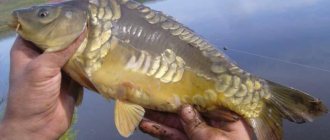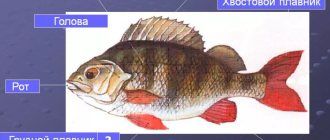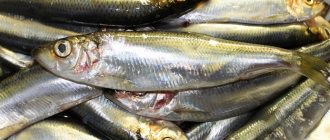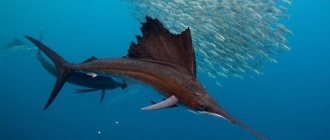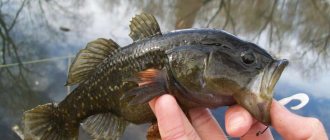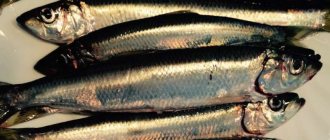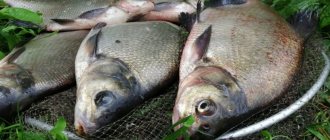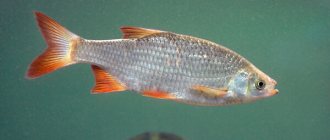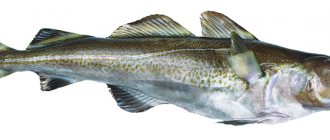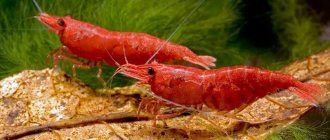Croaker doesn't like fuss
Croaker is a fish that loves to “hang out” among underwater rocks and stones. Divers, moving through the gloomy kingdom of Neptune, recognize drummers by their round, flattened silhouettes and lazy immobility. It seems that the flock is held in place by many invisible ropes. The sleepy state is deceptive: an awkward movement of the diver - and the “company” of croakers instantly disappears into the grotto.
Although the croaker is a large fish (some individuals reach a length of 70 cm, and there are also more substantial specimens), it cannot be seen from the surface of the water. A lover of quiet and secluded places, the croaker prefers to stay close to algae and cheerfully scurrying small fish: here both a table and a home are always ready for it.
Finding himself close to a dense living curtain of drummers, the hunter tries to immediately throw a harpoon at random, hoping that it will immediately return with prey (or even double). But, as a rule, it is not possible to spear fish so easily, since Corvina has a lightning-fast reaction.
It is better to catch croaker at dusk
The croaker has no commercial significance, but amateur fishermen catch it. This fish is especially popular among underwater hunters on the Black Sea coast of the Caucasus. But catching and shooting this fish is not so easy... Croaker is divided into two types - light (Umbra cirrosa) and dark (Sciaena umbra). Both species are found in the Black Sea, the Kerch Strait and adjacent parts of the Azov Sea. The body of the croaker is not too long, compressed laterally, and the back is humped in front. The head is small, rounded. The upper jaw protrudes forward.
How to catch.
Croaker are usually caught both from the shore and from a boat. This fish almost always sticks to great depths, so when fishing from the shore you need to use long-range gear. Diving in the area of Anapa and Novorossiysk, I usually met croakers at a depth exceeding 6-7 m, and, as a rule, no closer than 50-60 m from the shore. However, in Crimea, in the New World region, there are places where croakers live near coastal rocks.
To successfully catch croakers, you need not only to have properly made gear, but also to wield it clearly. The fact is that, confidently grabbing the nozzle, the croaker often hooks itself, but then it can throw itself under a rock or stone, and it is not always possible to pull it out of there.
Croaker fish best at dusk. At this time, it comes closer to the shore to feed, often appearing in the area of pebble beaches in the hope of profiting from mollusks and crustaceans living on the stones. Sometimes in shallow water it hunts for fry.
For bait, use fresh shrimp - live or dead, it doesn’t matter. Another good bait is the polychaete sea worm, but on rocky bottoms there are a lot of small fish that often find the bait faster than the croaker.
You can stock up on the required amount of shrimp using a small net with a small mesh, but with a fairly long handle. Shrimp often live in algae that grow over boulders, breakwaters, and piles of various structures. Shrimp also live in algae, which is sometimes abundant in small quiet lagoons and bays. A net is passed over the algae and thus the shrimp are caught. It is better to store shrimp in a spacious container with a small amount of salt water and algae, in which these crustaceans are preserved for a long time.
The sea worm lives on damp sandy or muddy coasts, at depths from 30 to 100 cm. It is mined using a shovel. It is better to preserve the sea worm in the soil from which it was obtained.
To the donk.
It is best to fish with bottom surf gear early in the morning and at dusk, when beach life dies down and the fish are not afraid to approach the shallow water zone. However, it must be taken into account that the croaker is a very shy fish and therefore rarely goes to depths of less than one and a half meters. Vast rocky shallows adjacent to sharp depressions at depths of 7-15 m are suitable for bottom fishing. Casts are made to areas with a flatter and weed-free bottom. You should also avoid throwing into heaps of stones to avoid getting caught.
Sea bottom tackle designed for surf fishing is usually based on a long 4-5 m surf rod. This rod is made of lightweight carbon fiber, has rings for passing the fishing line, a reliable connection of the knees, a comfortable handle that allows casting with two hands, and a holder for the reel. The rod should be quite rigid. The reel used is a spinning reel with a spool with a diameter of 50-70 mm. At least 150 m of monofilament fishing line with a diameter of 0.5 mm or strong braided fishing line is wound on it, allowing you to fish in stones and boulders, where there are frequent snags. In order to avoid breaking the entire tackle, 1.5 m of smaller diameter fishing line is tied to the end of the main line, on which the equipment is attached.
A very common rig includes three or four leashes, 10-15 cm long and 0.3-0.35 mm in cross-section with hooks No. 6-8, which are tied at intervals of 25-30 cm to the main line, starting from the end sinker weighing 100-150 g (Fig. 1). A possible rigging option is when a heavy sliding sinker is fixed on the fishing line above the end leash. The latter is connected through a swivel, which acts as an anti-twist and stopper for the sliding sinker. Here the recommended length of the lower leash is 17-23 cm, the upper one 15-17 cm. It is better to make the upper leash sliding with a small range of free movement between two beads, which in turn are blocked by short cambrics, stopped by wires. With a sliding leader, the fish does not feel resistance at the initial moment of swallowing the bait. The sliding leash can be put on through a swivel (Fig. 2).
In some cases, when fishing among large stones, in order for the fish to find the bait faster, it is necessary to slightly raise it. To do this, place a float on the fishing line near the leash. It can be made as follows: an oblong-shaped solid foam is taken, a hole is made in it, into which a tube made of non-oxidizing and stainless metal is tightly inserted. The smallest passage ring is tightly placed on the end of the tube protruding from the foam plastic; the leash will then be attached to it (Fig. 3). In another version of the equipment, foam floats are installed on leashes. Floats should be of a minimum size so that they can only slightly lift the bait off the ground. They should be painted gray or faded green so that they are not so conspicuous to the fish. For fastening to a fishing line, a through hole of minimum diameter is made in the floats, into which a copper wire of appropriate thickness is inserted for fixation (Fig. 4).
Typically, fishermen engaged in sea bottom fishing have 2-3 such gear on the shore. For ease of fishing, they install them on special holder stands. When fishing for croaker, it is advisable not to be away from the bottoms for a long time, and when fishing in the dark, supply them with bells. At the first strong pull, it is necessary to make a sharp hook and, without allowing the croaker to go into the stones, begin to quickly fish it out.
On a fishing rod with a sliding float.
Fishing from rocks usually takes place at a depth that can be very significant, so that the cast can be made almost under the rock. In such places there is often a clean rocky bottom or littered with boulders and stones, often with thickets of vegetation, crevices, cracks and other places where a predator can hide in ambush and small fish can hide from it. Tidal phenomena in such areas do not play a noticeable role in increasing or decreasing the water level, so fish are fearless near the rocky shore and it is not at all necessary to search for it by resorting to long casts. It is convenient to fish from the rocks with a spinning rod, and you can also use float gear, donka and even longlines. As a rule, depths in rocky areas can have significant differences from 3 to 20 m or more.
In the evening, when the croaker comes close to the shallows, you can fish with long-range float tackle from piers and sloping shores. Marine match tackle allows you to cast baits 50 meters or more. For fishing on rocky bottom areas, hard carbon-fiber rods are suitable, which are subject to heavy loads in case of snags. The coil used is inertialess. Light rods designed for surf fishing are quite suitable for such fishing; Most of them have the word “surfcasting” written on them. You can also use long two-handed spinning rods up to 4.5 m. The supply of fishing line should be so large that it is enough for a long cast and there is still a reserve of 15-20 m left. When, let’s say, “extreme” fishing for croaker, which, after being hooked, always rushes for cover, the main fishing line and leash are necessary set strong ones (0.3 and 0.25 mm, respectively). When fishing from rocks or from a boat, you should always try to immediately tear the fish off the bottom. A sliding float is put on the fishing line, which in working condition is locked on top with a tiny rubber cambric or a sliding knot that regulates the depth, and when casting, with a lead shot installed above the sliding sinker (40-50 g). From below, not reaching the hook (Nos. 7-9), the sinker is stopped with a second pellet. Next comes a leash with a hook. Casting is done in the same way as when fishing with a spinning rod. After casting, the sinker and bait fall to the bottom. The float, held by the cambric on the surface, signals a bite. In some cases, the emphasis on the line is not installed. In order for the float to rise, after lowering the weight and bait to the bottom, you only need to smoothly pull the line.
Sometimes the croaker stays under the edges, where the bottom is covered with an even layer of small pebbles. Such places can be found between Anapa and Utrish. Here it is more effective to fish with gear drifting under the influence of the current or wind. The nozzle moves 10-20 cm above the bottom. For this type of fishing, a torpile sinker is used, that is, a sinker that has foam inside the lead shell, balancing the gravity of the lead.
If fishing takes place far from the shore, the boat or boat is placed on guy lines thrown from the stern and bow, that is, two anchors are used, which are located 20-30 m from the vessel and securely fix it so that there is no looseness on the waves. In this case, the angler must ensure that the ends do not interfere with casting.
You can also catch croaker using the drifting method - i.e. when the craft is not anchored and the abandoned equipment drifts with the boat downstream or downwind.
The technique of drift fishing is not much different from conventional fishing with a float rod. However, the release of the nozzle can be more than tens of meters. It should be taken into account that croakers deeper than 40 m are rarely found in the Black Sea. For deep fishing, large floats with special fastenings are required, which can be easily removed when fishing for large fish so as not to create an obstacle. The nozzle should be near the bottom. A bait consisting of a mixture of finely chopped pelagic fish (mackerel, anchovy) will not hurt. For greater catchability on a drifting vessel, you can use several fishing rods at once or equip one with several leashes.
Using an echo sounder.
When searching for croaker habitats, an echo sounder can be of great help. It makes it possible to determine the depth, bottom topography and location of the slab. These devices operate on the principle of reflecting ultrasonic signals from objects or objects located under water. The reflected signal is transmitted electronically to the display screen, and the person sees a relief image of the bottom. It must be said that for their shelter, croakers often choose a pile of boulders, slabs and rocks at the bottom, which are easily readable using an echo sounder. It is in such prominent areas that you need to catch croaker. The echo sounder is installed on a boat or boat in the front part behind a protective shield so that water does not get on it when moving. Stepwise rotation of the device 360 degrees horizontally and 90 degrees vertically allows you to determine the location of large fish in any direction from the vessel.
The device adjusts automatically and has a backlit screen for night-time operation. Everything that comes within the range of the device is reflected on the display, including the size of the fish and its depth. The device has the ability to enlarge the underwater image several times if circumstances require it. If your boat has an echo sounder, it automatically shows the depth under the keel. Using an echo sounder, you can find depressions, underwater banks, edges, fairways and other relief features.
The dark croaker reaches 70 cm in length, and its weight reaches 4-5 kg. This is a schooling, heat-loving fish that usually lives near rocky cliffs. Found from late April to December. Large concentrations of schools of croaker, and their activity was noticed in July-August off the coast of the Black Sea coast of the Caucasus. Spawns in portions at a fairly high temperature - not lower than 19 °C. The caviar is pelagic, the fertility is not high - 6-500 thousand eggs. The croaker feeds on small crabs, shrimp, and small coastal fish (gerbil, anchovy, sprat, horse mackerel). In winter it goes deeper. The lifestyle is little studied, apparently due to the small size of the fish population.
The light croaker is larger than its dark counterpart and reaches a length of 1.5 m and weighs up to 30 kg. It is even less common than the dark one, and its way of life is also little studied. It lives in the same places as the dark croaker, and spawns in April-May at lower water temperatures, but with very high fertility - up to 3 million eggs. It feeds on worms and fish (small mullet, anchovy, red mullet), and also does not disdain crabs, shrimp and mollusks. In winter it also goes deeper, and lives near the coast from April to December.
Trusting but cautious
Indeed, the croaker fish is not afraid of divers (it generally tends to chase away small fellow fish in its habitat). But a person should not act according to the principle “impudence is the second happiness of fishing.” The flock instantly mobilizes: there was a fish, but it swam away, only wagging its tail in a dark crevice. The second exit will occur only in a few hours and will be much more careful. True, the very next day the croakers “do not remember the evil,” they are again calm and trusting. Smooth progress, precise aim - and good luck awaits the harpooner. He will definitely return home with glorious booty, for which he started his underwater voyage.
In the Black and Azov Seas there are two types of croaker - light and dark. The black one is found in the eastern Atlantic Ocean. So the geography of hunting can be very diverse, the main thing is to understand the peculiarities of fishing well - and go ahead! On the Russian Fishing forum, the light croaker fish is described as a rarer species, which is larger than its dark counterpart. It has antennae on its lower jaw. He is a tasty prey for fishermen. Amateur fishermen successfully catch umbrina (light croaker) from the shore, as well as from a boat. The last method is inconvenient: the croaker quickly grabs the bait and runs away into the rocks. It is very difficult to pull it out of there while remaining on the surface of the water. More often, preference is given to fishing rods, since modern gear can be cast at a distance of up to 50 meters from the fisherman’s location. A rigid carbon fiber fishing gear or donk is suitable (since snags are possible, you need to take a strong fishing line with a thickness of 0.6-7 mm). A spinning rod is also good, which can easily take out grunts.
So, you decided to go after such prey as croaker fish. What to catch her with? This question worries many fishermen. There are so many fishing methods that their description could fill a hefty volume.
Gorbyl
Most of the fish species on the Black Sea coast that live in Anapa are lucky with their names. Some received beautiful and proud nicknames of land dwellers, others the names of fairy-tale characters, an example of this is the sea dragon. The marine representative, which will be discussed in this article, was unlucky with his name; due to a slight unevenness in his back, he is called the croaker. Despite the offensive nickname, the sea croaker is a very worthy fish, which is listed in the Red Book. It is a great honor for hunters and fishermen to catch one of the species of croakers that live in Anapa. Take a photo with the trophy to show off to your friends and colleagues.
Appearance
Three species of croaker live in the Black Sea; in the area of the resort town of Anapa, only two are often found. The light croaker or Umbrina, scientifically called Umbrina cirrosa, is the largest in our sea. Over time, the fish acquired an elongated body, quite compressed from the sides. The head is large with a beak-shaped stigma, the mouth is located almost horizontally to the body. The dorsal upper fin is undivided with a distinct notch. The main features of the light croaker are one fleshy barbel on the lower jaw and dark edges of the gill covers. The croaker of this species is characterized by a light color with wavy stripes running at an angle to the tail. Yellowish stripes with dark edges are clearly visible on the body of the croaker and serve as excellent camouflage. The lower part of the body is lighter, with reddish ventral fins clearly visible on it. The edge of the caudal fin is without a notch, almost straight. The large Black Sea croaker can be up to a meter long and weigh about 30 kilograms.
The second variety of rare Anapa fish is the dark croaker (Sciaena umbra). Smaller than its counterpart in appearance, nevertheless, specimens up to 60 centimeters and weighing 4 kilograms were found online. The back of this marine representative has a clear round curve, similar to a hump, which ends with a large head with a rounded nose. On the body you can see a clear lateral line that reaches the caudal fin. A distinctive feature is the caudal fin, which has a convex, rounded shape. The dorsal fin is undivided and, together with the tail, has a yellow tint. Depending on where they live, the dark croaker has different body shades. In Anapa there are fish with silvery sides and a light belly. The fins are much darker than the body.
Habits
Black and light croakers live in the same places; they love rocky shores, stone ridges, and underwater caves. They prefer depths of 3 meters and above. The light croaker spawns first; it is more cold-loving; its mating season begins in the spring. The dark croaker waits for the water to warm up to 19-20 degrees and spawns in the summer. Local fish spawn in batches; the female lays eggs directly into the water column. Then the larvae spread over the surface and wait until they mature. On the fourth day of their existence, small croakers begin to feed on their own and gain weight. The favorite foods of adult Anapa fish are mollusks, crustaceans and sea worms. In winter, the fish go to depths where the water temperature remains constant.
Interesting Facts
When traveling to other countries, many tourists notice similar Anapa croakers in fish markets and restaurants. Varieties of croaker fish are found far beyond the Black Sea, and this fish is caught in many coastal cities around the world. Crocker, this name has taken root in other states. Adult croaker croakers have well-developed air bladder muscles. Due to its property, the croaker can make sounds similar to quacking sounds, it turns out: “krok-krok”. For its unique vocal ability, the fish received the nickname “crocker”. Also the English word croak can be translated to wheeze, croak or croak.
Where to see in Anapa
Croaker in Anapa is not a widespread commercial fish. Sometimes fishermen come across local crockers in their nets, and then you can buy rare fish in Anapa markets. Croaker meat is recognized as one of the local delicacies. Sea hunters consider the croaker a worthy trophy. Therefore, the famous fish can be seen on the kukans of Anapa spearfishing enthusiasts.
Changes color
A freshly caught dark croaker is the spitting image of a chameleon, initially golden-black, nobly shiny. However, after a while it turns white. A little more passes, and the original appearance returns, only duller. Nutritious, tasty, rather expensive croaker fish (the price, according to some sources, ranges from 300 to 1000 rubles per 1 kilogram) is valued in cooking. Many dishes are prepared from it, even entrecotes.
In its native water element, Corvina looks much “more cheerful” (than in a frying pan): the black, or rather dark purple, color is shaded by light bronze on the sides and gills. The belly is silvery-white, the fins are snow-colored. Sheer elegance! The slowness and importance of the breed is explained by the fact that it has few enemies in the water element.
The drummer feeds on small animals, shellfish, and loves crabs. At night, at high tide, it rows to the shore to easily collect prey. In other cases, the croaker prefers to be at a depth of 6-8 meters. In flock families live individuals of different sizes and ages. The houses are large blocks of stone and deep slabs.
When and where to fish
There are two types: black and white. Please note that the second species is listed in the Red Book. Unlike previous fish species, croaker are best caught at night. They bite during the periods from sunset to one in the morning and at dawn. It lives at depth, in the area of boulders, in rocks and caves. It is advisable that these places are far from the shore. It usually groups and hunts in groups of several individuals. All fishermen want to catch it, because it is one of the most popular fish in the Black Sea. It starts pecking in April. Almost never lives at a depth of less than 2 meters. Fishermen believe that before starting to catch croaker, it is necessary to catch all the scorpion fish from that area so that it stops showing signs of activity. This is necessary in order not to lose those minutes when the croaker’s family swims by. He never gets off the hook because of the soft, fleshy lips, but he can break or bend it. Also, strong jerks can break the cord.
They do not like and attack fish that swim up to their ambush. The main food item of the croaker is fish up to 25 cm. You should not try to catch it in winter - the fish goes to great depths far from the shore. Spawning takes place in the summer, not far from the shore.
Its bite is like a powerful pull, after which there is a jerk into the depths.
Lives settled
Flocks do not like to change habitats. When drawing up a plan of action, sea hunters take this principle of sedentism into account. After approaching the fishing spot, all they have to do is carefully comb large crevices and rocks, wander among underwater rocks, go into grottoes, and look under slabs. Here he is, the croaker! Fish will definitely show up.
We have already said that you need to search very carefully. Metal parts of underwater equipment clanking against rocks can ruin everything. Experienced hunters have come up with many methods to muffle and soften possible blows. Insulating tape is used. Wrapping gun barrels and receivers with it is a matter of minutes, but what a benefit! To soften the contact between equipment and underwater objects, craftsmen also use used rubber from bicycle inner tubes.
Lighting will help
In the Black Sea, underwater “croaker lands” have long been developed. Numerous hunters and divers have changed the habits of the fish. Usually trusting, the croaker almost never walks in the open air, much less stands in family schools and, as hunters say among themselves, does not form a “hanging”.
When you see a long-awaited group of croaker fish in the open, do not rush to release the harpoon. Trapping fish in a shelter is what you need! Even when it seems to you that there is nothing under the stone, don’t believe your eyes. Better turn on your underwater light and check again. Surely there are gorgeous specimens lurking in the thick darkness! It is not necessary to carry the beacon with you all the time. You can leave it on the buoy and use it if necessary.
In search of fish, move along the shore in a zigzag: sometimes moving away, sometimes approaching land. If the stones are less than one and a half meters in diameter, you can bypass them; examine large ones carefully. Study the shelf, terrain, location of cliffs. Talk to local residents - any information can be useful. The high cliff on land continues under water. In terms of hunting, narrow stone rows (ridges) are interesting.
Appearance and varieties
The dark croaker, the photo of which is located under the first paragraph, has one of the largest populations among its family. It can be found in the waters of the Black and Mediterranean Seas, and the eastern part of the Atlantic Ocean is also rich in it. The fish grows up to 70 centimeters in length, with an average weight of up to 4 kilograms. It has a dark blue back that can vary from dark blue to copper red, with golden sides. Although the croaker is quite widespread, in some places the population size is limited.
Dark croaker
The light croaker, the photo of which is located below, is somewhat larger than the dark one. This fish can grow more than a meter in length, while gaining weight of more than 30 kilograms. Its body structure is practically no different from other representatives of its species. The differences include a brown back with a silver sheen, and the sides are painted a pale golden color, which is clearly visible in the photo. Differences also include the presence of a short and thick mustache, which is located on the chin.
Light croaker
In the waters of the Yellow Sea you can find small yellow croaker. This fish has the highest numbers. Due to this fact, the yellow croaker has a very high commercial value. This fish grows up to 35 centimeters and has a body weight of up to 1 kilogram. This croaker is caught using fixed and drift nets and trawls.
In the waters of the Indian Ocean and the South China Sea there is a red croaker, which you can see in the photo below. It grows more than 85 centimeters in length. Gains weight up to 7 kilograms. The main distinguishing feature of this type of croaker is the presence of a pair of fangs with which the upper jaw is equipped.
Red croaker
Near the Spanish, Portuguese and Moroccan coasts, there are large numbers of eagle croaker, which can be seen in the photo below. It also has significant commercial significance. The average body length reaches one and a half meters. In weight, average individuals can gain up to 25 kilograms.
Eagle croaker
Stock up on float
Enter from the side of the closed ridge in the direction from the depths to the shore. When looking into a crevice, keep your gun ready. By the way, the croaker loves the space under pieces of slabs that have fallen off from the underwater hill. Often a signal that there are large drummers somewhere nearby is the presence of schools of small fish - swallows. 15-centimeter “girlfriends” are “hovering” over the stone - check all the shelters below. Swallows, unlike croakers, can also be seen from the surface.
Having found the stones where the grumpy is lying, mark the place with a bright inflatable buoy. Otherwise, you can easily lose it. Thus, it is worth making sure that the float is always with you. A buoy is a multifunctional thing: you can hang a flashlight, a kukan (a device for carrying fish), a spare gun, etc. on it.
On the donk:
You have to fish in boulders and stones, where there are often snags, so the main fishing line must be thick, about 0.6-0.7 mm. The equipment used is quite primitive. Take hooks No. 6-8, tie them to three or four leashes with a length of 10-15 cm and a cross-section of 0.3-0.4 mm, which are attached to the main fishing line at intervals of 25-30 cm, starting from a sinker weighing 100-120 g, located at the very end of the tackle.
The croaker fish grows to a decent size. therefore it is so desirable for any fisherman.
When fishing among large stones, the nozzle must be slightly raised so that the fish finds the bait faster. For this purpose, a float is attached to the fishing line near the leash. It is made of oblong-shaped hard foam, a hole is drilled in it, and a tube of metal that is not capable of rusting or oxidizing is tightly inserted into it. The smallest passage ring is also tightly placed on the protruding end of the tube, and a leash is attached to it.
For successful fishing, it is important to choose the right fishing spot and throw the tackle quite far from the shore. The rod must be strong and long and rigid; this condition is necessary for a good casting distance. The reel also meets these requirements. Fishermen throw two or three similar gears. They are thoroughly strengthened on special holder stands. When catching croaker on a bottom, you should not leave the chosen place unattended for a long time. With the onset of darkness, when fishing with a donk, bells should be tied. When you first pull the line, you need to make a sharp hook and begin to quickly fish out the croaker, not allowing it to go into the stones.
Get into the right position
A few additional hunting rules:
- The tip of the harpoon should be directed strictly in accordance with your view (sight).
- If the croaker in the hole is relatively easily accessible, you can shoot immediately, but if the fish has its head or tail turned towards you, wait until it turns around.
- Sometimes drummers find themselves in difficult positions. Maybe they are barely visible through a crack, are hidden by a stone, or are darting from side to side, trying to dodge an uninvited observer.
- What if you take a flexible position? For example, go in from the right side, leave a glove or a flashlight there, and then move to the left side of the shelter and push the gun deeper? Squeezed by circumstances, the croaker will stop turning and become accessible prey.
- Before you pull the trigger, figure out whether you can eventually get the grunt. Pull carefully, otherwise it will fall off the tip - and goodbye, catch! You can try the opposite method: go to the other side of the stone, drag the fish with a harpoon and only then take up the gun.
- Whenever you have the opportunity to grab a fish, do it. Holding the harpoon with one hand, press the croaker with the other. Strong fish are easy to break, so it’s better to be on the safe side. Before removing the drummer from the spear, place him on the kukan, piercing his head from below through the gills with a needle.
Wherever the croaker fish is found - the Black Sea, the Azov Sea, the ocean expanses - this is not a reason to behave predatory. A real underwater hunter never seeks to exterminate the entire school. I caught two or three fish and that was enough. This is the wisdom of life, however!
Spinning fishing for croaker
> What to catch > Other fish > Spinning fishing for croaker
The croaker is a bottom predator and shows little activity during the daytime. Usually the croaker spends time at depth near various shelters, mainly grottoes and caves. As a rule, the croaker searches for prey by carefully combing the unevenness of the bottom.
Catching croaker using a spinning rod
It is mainly fished with a variety of jig baits and wobblers. But if you choose between jig baits and wobblers, then a wobbler is more effective for catching croakers. So the ratio of bites on a wobbler and on a jig is approximately ten to one.
However, a question arises here, because a wobbler is primarily a bait for surface fishing. While rubber is a bottom bait.
After all, rubber, as a rule, imitates a small wounded or sick fish, which for a predator is an excellent object for attack. But in the croaker’s diet, fish makes up a little more than 10%, and the basis of its diet is crabs, shrimp and various invertebrate mollusks; fish occupies the last place in the croaker’s diet. After all, the fish is nimble and fast, you still need to chase after it, but the slow crab is always nearby, almost under your nose.
A wobbler also imitates a fish, but only if this bait works as expected, classically. But a wobbler can also imitate a crab. Such a wobbler is a fet or crank, which is compact, round and also has a rattle inside. But the crabs crawl along the bottom, while the wobbler moves in the water column. This means the wobbler must lure the croaker, which means working along the bottom. Loading a wobbler is not a very good option, since the croaker does not favor a floating wobbler during a stop. You can, of course, use a wobbler with a large depth, but fishing for croakers requires medium-sized wobblers, and with these, the depth usually rarely exceeds 3 meters. And fishing for
croaker using a spinning rod
is usually carried out at depths of 3 meters or more.
Then you should use a leader rig such as a drop shot. The bait has the following form: a triple swivel is attached to the main line, and a Tyrolean stick on a short leash (12-15 cm) is tied to the lower ring. And a leash about a meter long is mounted to the remaining free wheel; at the end it has a carabiner to which the bait is attached. As a result of such manipulation, the smallest baits can now be passed along the bottom.
The wobbler should be driven very slowly, then the result is an imitation of it crawling along the bottom and scraping against the stones, perfectly imitating a crab crawling along the bottom.
A little about baits, the most practical bait for catching croaker is a crankbait with a long blade like a cherry from a jackal or chubby; feta croakers also work well.
Since this fish is caught at night, color does not matter much here.
By the way, such baits have much fewer hooks than when fishing with jig baits. Most likely, when you stop the wiring, the rubber band, when it falls to the bottom, may fall into the cracks between the stones, but the wobbler, on the contrary, floats out. In addition, the blade serves here as a bump stop. In addition, a wobbler can be used to make a non-hooking bait. For example, if you look closely at the tee of a wobbler, you can see that two tips are sticking up, and one tip is looking down. And here you just need to bite off such a tee with pliers. This will not reduce the number of effective bites, but there will be significantly fewer hooks.
Experienced fishermen have noticed that if you put a firefly on the cambric in front of the wobbler, but not a new and bright one, but an already used and slightly faded one, then the intensity of bites increases to 20%. And during a bad bite, this significantly improves it.
But rubber also provides good opportunities to experiment. It happens that croaker responds better to small baits, but it also happens the other way around when this fish responds better to large baits. The same applies to the methods of wiring; you also need to experiment with them; today the croaker bites better during a stepped retrieve, and tomorrow it will be more attracted to the bait with a uniform retrieve.
When biting, the croaker, as a rule, makes only one dull poke, which is perfectly felt by the angler’s hand. Moreover, the smaller the individual, the more violent and exciting the bite.
For sea spinning, rods 2.7-3.2 m long are used. This gives good casting range. Thus, catching croaker with
a spinning rod
of this length is the most optimal. In addition, such spinning rods are good for catching flounder. This spinning rod also has its advantages in catching prey.
As for the spinning rod structure, it depends on preferences, since a parabolic and structurally similar structure gives good advantages in the casting range of the bait. Fast sticks are more sensitive, but it's best to settle for the sweet spot with a medium or medium-fast action. The weight of such a rod should be about 15 grams, but you can fish with a mid-class rod. A very important detail is the material from which the spinning rod handle is made. It is quite clear that most good poles have cork handles, but cork quickly becomes unusable after contact with salty sea water. Therefore, for sea fishing it is more practical if the handle is made of polymer materials.
There are no special requirements for the reel, as long as it is smooth and soft. However, you should always carefully monitor the quality of lubrication of the line-laying roller, as it quickly wears out. Another pressing issue is to use monofilament or braided cord. Most spinning anglers prefer monofilament for trolling, and in other cases use braided line.
Since the croaker fish is quite rare, it is recommended to release back individuals weighing less than 1 kilo. After all, concern for increasing fish stocks and the survival of a particular species largely depends on amateur fishermen.
Published: 03/01/2015
Other interesting materials:
| Fishing equipment Do you know what equipment your… | How to seduce autumn pike? Any angler knows that autumn is the best time for... | Dynamic jig baits - twisters and vibrotails Twisters Twisters are dynamic baits made from... | Choosing an anchor line for fishing and pleasure craft Any owner of a small craft, even such a rowing… |
